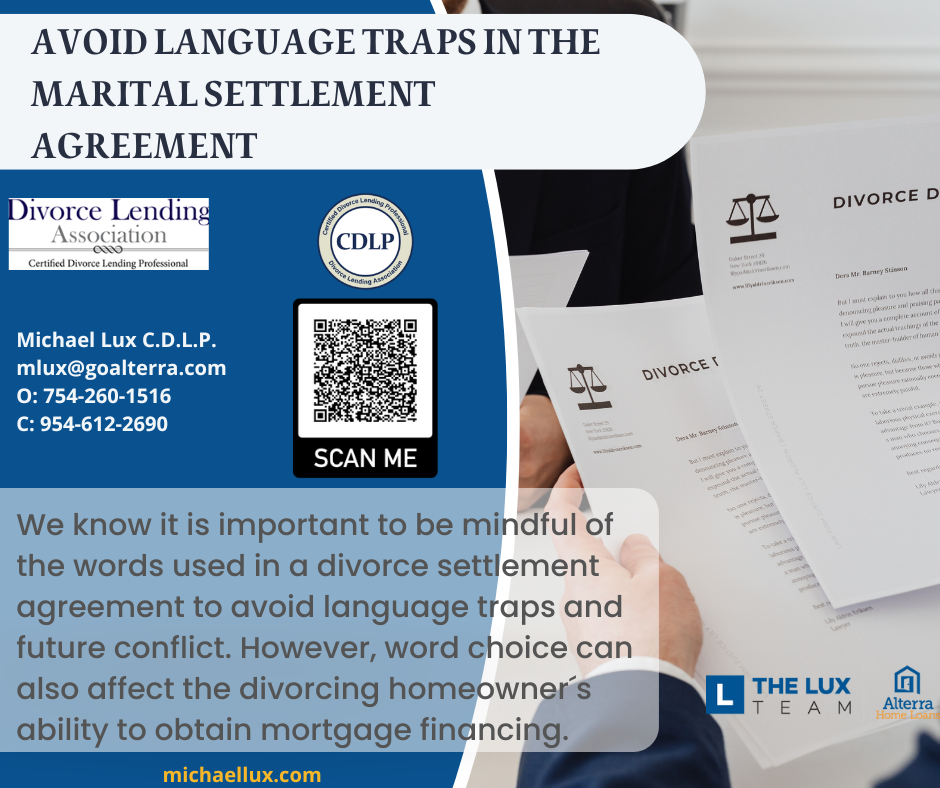
We know it is important to be mindful of the words used in a divorce settlement agreement to avoid language traps and future conflict. However, word choice can also affect the divorcing homeonwer’s ability to obtain mortgage financing. Therefore, while it may not be top of mind to word the divorce settlement agreement to meet mortgage guidelines, it could significantly help divorcing homeowners to clarify specific terminology used in the settlement agreement.
Make Sure Your Words Mean What You Think They Mean
The terms “alimony,” “maintenance,” and “spousal support” are often used interchangeably to describe payments made by one spouse to another after a divorce. The terms may be identical in meaning but not necessarily in the eyes of an underwriter.
As an example: From a liability/debt perspective, some agency guidelines differentiate between alimony and maintenance while other agencies do not.
Suppose your divorcing client is paying ‘maintenance’ and needs to obtain mortgage financing. In that case, you can help them avoid terminology issues by clarifying that alimony and maintenance are considered the same. It could be beneficial to include a clarifying statement such as:
“All maintenance payments paid by Husband to Wife according to this agreement are intended to constitute alimony.”
Does it really make a difference?
Here’s an example:
Joe is ordered to pay Jane 30% of his gross monthly income as spousal maintenance. Joe would like to purchase a new home; however, the monthly maintenance may have a negative affect on his buying power.
| Joe’s Gross Monthly Income Adjustment for Maintenance |
$10,000 | $10,000 ($3,000) |
| Adjusted Gross Monthly Income | $10,000 | $7,000 |
| Debt Load: Monthly Maintenance |
$850 $3,000 |
$850 |
| Debt-To-Income (DTI) Ratio Before Housing | 39% | 12% |
| Max DTI of 45% – amount available for new housing expense | $650 | $2,300 |
In certain situations, Joe’s maintenance payment could be reduced from his gross income rather than classified as a true debt or monthly obligation. The above table illustrates the positive effect of adjusting the monthly maintenance obligation and increases Joe’s purchase opportunity from a housing payment of $650 per month to $2,310. However, specific lending agencies will only allow this adjustment for alimony, and if the clarification statement above is overlooked, it may limit Joe’s ability to obtain mortgage financing.
Divorce Mortgage Planning will have a profound affect on a divorcing homeowner’s mortgage opportunities.
Contact a CDLP for Assistance
Work with a Certified Divorce Lending Professional to make sure there are no language traps between the intent of the divorce settlement agreement and mortgage guidelines. It is much easier to get it right the first time than risk mortgage denial because of word choices or lack of clarification. Here’s some help tracking down a CDLP in your area.
This is for informational purposes only and not for the purpose of providing legal or tax advice. You should contact an attorney or tax professional to obtain legal and tax advice. Interest rates and fees are estimates provided for informational purposes only and are subject to market changes. This is not a commitment to lend. Rates change daily – call for current quotations.
Always work with a Certified Divorce Lending Professional (CDLP) when going through a divorce and real estate or mortgage financing is present.

Recent Comments